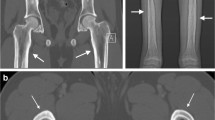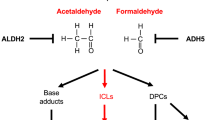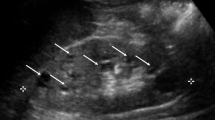Abstract
Osteogenesis imperfecta (OI) type VI is a rare inherited disorder of the connective tissue caused by pathogenic variants in SERPINF1 gene, which encodes the pigment epithelium-derived factor (PEDF). PEDF is implicated in many biologic processes, including an anti-cancer role. This information is supported by in vitro and in vivo studies that evidenced its anti-angiogenic, anti-tumorigenic, and anti-metastatic properties. Although OI is related to skeletal changes such as bone fragility and deformities, as well as to other connective tissue defects, it does not represent a greater predisposition to the development of skeletal tumors. Here, we report on an adult with OI in which a deletion in exon 8 of the SERPINF1 gene (c.1152_1170del; p.384_390del) was identified. The patient presented popcorn calcification in both femoral epiphyses, but one of them presented radiological characteristics and evolution suspected of malignancy. Later, it was diagnosed as chondrosarcoma. This paper discusses that OI type VI patients may be at risk of developing some types of cancer.



Similar content being viewed by others
References
Forlino A, Marini JC (2016) Osteogenesis imperfecta. Lancet [Internet]. 387(10028):1657–1671. https://doi.org/10.1016/S0140-6736(15)00728-X
Tauer JT, Robinson ME, Rauch F (2019) Osteogenesis imperfecta: new perspectives from clinical and translational research. JBMR Plus 3(8):1–10
Trejo P, Palomo T, Montpetit K, Fassier F, Sato A, Glorieux FH et al (2017) Long-term follow-up in osteogenesis imperfecta type VI. Osteoporos Int 28(10):2975–2983
Joeng KS, Grover M, Rajagopal A, Lee BH (2014) SERPINF1 as a cause of osteogenesis imperfecta type VI. In: Shapiro JR, Glorieux FH, Byers PH, Sponseller PD (eds) Osteogenesis imperfecta: a translational approach to brittle bone disease. Academic Press, London, pp 167–172
Mandziak DG, Clayer M (2013) Chondrosarcoma in a patient with osteogenesis imperfecta. ANZ J Surg 83(10):794–795
Douis H, Saifuddin A (2013) The imaging of cartilaginous bone tumours II Chondrosarcoma. Skeletal Radiol 42(5):611–626
Minillo RM, Sobreira N, De Fatima M, De Faria S, Jurgens J, Ling H, Hetrick KN et al (2014) Novel deletion of SERPINF1 causes autosomal recessive osteogenesis imperfecta type VI in two Brazilian families. Mol Syndromol. 5(6):268–275
Liu Y, Asan, Ma D, Lv F, Xu X, Wang J et al (2017) Gene mutation spectrum and genotype-phenotype correlation in a cohort of Chinese osteogenesis imperfecta patients revealed by targeted next generation sequencing. Osteoporos Int. 28(10):2985–2995
Lyall V, Shih V, Chung C (2017) PEDF: an essential stem cell regulator in models of osteogenesis imperfecta type VI. J Rare Dis Res Treat 2(4):20–24
Broadhead ML, Akiyama T, Choong PFM, Dass CR (2010) The pathophysiological role of PEDF in bone diseases. Curr Mol Med 10(3):296–301
Venturi G, Gandini A, Monti E, Carbonare LD, Corradi M, Vincenzi M et al (2012) Lack of expression of SERPINF1, the gene coding for pigment epithelium-derived factor, causes progressively deforming osteogenesis imperfecta with normal type I collagen. J Bone Miner Res 27(3):723–728
Klinger P, Lukassen S, Ferrazzi F, Ekici AB, Hotfiel T, Swoboda B et al (2017) PEDF is associated with the termination of chondrocyte phenotype and catabolism of cartilage tissue. Biomed Res Int 2017:7183516. https://doi.org/10.1155/2017/7183516
Akiyama T, Dass CR, Shinoda Y, Kawano H, Tanaka S, Choong PFM (2010) PEDF regulates osteoclasts via osteoprotegerin and RANKL. Biochem Biophys Res Commun [Internet]. 391(1):789–94. https://doi.org/10.1016/j.bbrc.2009.11.139
Belkacemi L, Zhang SX (2016) Anti-tumor effects of pigment epithelium-derived factor (PEDF): implication for cancer therapy: a mini-review. J Exp Clin Cancer Res [Internet]. 35(1):1–14. https://doi.org/10.1186/s13046-015-0278-7
Becerra SP, Notario V (2013) The effects of PEDF on cancer biology: mechanisms of action and therapeutic potential. Nat Rev Cancer [Internet]. 13(4):258–71. https://doi.org/10.1038/nrc3484
Zhang C, Yang W, Zhang S, Zhang Y, Liu P, Li X et al (2022) Pan-cancer analysis of osteogenesis imperfecta causing gene SERPINF1. Intractable Rare Dis Res 11(1):15–24
Tan ML, Choong PFM, Dass CR (2010) Anti-chondrosarcoma effects of PEDF mediated via molecules important to apoptosis, cell cycling, adhesion and invasion. Biochem Biophys Res Commun [Internet]. 398(4):613–8. https://doi.org/10.1016/j.bbrc.2010.05.098
Obafemi AA, Bulas DI, Troendle J, Marini JC (2008) Popcorn calcification in osteogenesis imperfecta: incidence, progression, and molecular correlation. Am J Med Genet Part A 146(21):2725–2732
Takahashi S, Okada K, Nagasawa H, Shimada Y, Sakamoto H, Itoi E (2004) Osteosarcoma occurring in osteogenesis imperfecta. Virchows Arch 444(5):454–458
Author information
Authors and Affiliations
Corresponding author
Ethics declarations
Conflict of interest
Débora Meira Ramos Amorim, Gustavo Kendy Camargo Koga, Rodrigo Nolasco dos Santos, Paulo Fernando Carvalho Secundo, Eloy de Ávila Fernandes, Leonardo Cardili, Sergio Setsuo Maeda, Artur da Rocha Corrêa Fernandes, and Marise Lazaretti Castro declare that they have no conflict of interest.
Ethical Approval
CEP/UNIFESP n. 0036/2017.
Human and Animal Rights
Our case report is under the ethical standards of the national and institutional committee on human study.
Informed Consent
Patient signed the informed consent to participate in this study after the protocol was properly approved by the Ethics Committee in Research (research number n. 0036/2017).
Additional information
Publisher's Note
Springer Nature remains neutral with regard to jurisdictional claims in published maps and institutional affiliations.
Rights and permissions
Springer Nature or its licensor (e.g. a society or other partner) holds exclusive rights to this article under a publishing agreement with the author(s) or other rightsholder(s); author self-archiving of the accepted manuscript version of this article is solely governed by the terms of such publishing agreement and applicable law.
About this article
Cite this article
Amorim, D.M.R., Koga, G.K.C., dos Santos, R.N. et al. Rare Association Between Osteogenesis Imperfecta and Chondrosarcoma: Could a Pathogenic Variant in the Gene SERPINF1 Explain It?. Calcif Tissue Int 112, 118–122 (2023). https://doi.org/10.1007/s00223-022-01033-4
Received:
Accepted:
Published:
Issue Date:
DOI: https://doi.org/10.1007/s00223-022-01033-4




